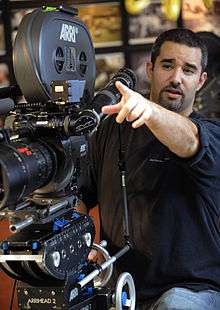Cinematographer

A cinematographer or director of photography (sometimes shortened to DP or DOP) is the chief over the camera and light crews working on a film, television production or other live action piece and is responsible for making artistic and technical decisions related to the image. The study and practice of this field is referred to as cinematography.
The cinematographer selects the camera, film stock, lens, filters, etc., to realize the scene in accordance with the intentions of the director. Relations between the cinematographer and director vary; in some instances the director will allow the cinematographer complete independence; in others, the director allows little to none, even going so far as to specify exact camera placement and lens selection. Such a level of involvement is not common once the director and cinematographer have become comfortable with each other; the director will typically convey to the cinematographer what is wanted from a scene visually, and allow the cinematographer latitude in achieving that effect.
Several American cinematographers have become directors, including Barry Sonnenfeld, originally the Coen brothers' DP; Jan de Bont, cinematographer on films as Die Hard and Basic Instinct, directed Speed and Twister. In 2014, Wally Pfister, cinematographer on Christopher Nolan's three Batman films, made his directorial debut with Transcendence; whilst British cinematographers Jack Cardiff and Freddie Francis regularly moved between the two positions.
History

In the infancy of motion pictures, the cinematographer was usually also the director and the person physically handling the camera. As the art form and technology evolved, a separation between director and camera operator began to emerge. With the advent of artificial lighting and faster (more light sensitive) film stocks, in addition to technological advancements in optics, the technical aspects of cinematography necessitated a specialist in that area.
Cinematography was key during the silent movie era; with no sound apart from background music and no dialogue, the films depended on lighting, acting, and set.
In 1919 Hollywood, the then-new motion picture capital of the world, one of the first (and still existing) trade societies was formed: the American Society of Cinematographers (ASC), which stood to recognize the cinematographer's contribution to the art and science of motion picture making. Similar trade associations have been established in other countries too.
Societies and trade organizations
There are a number of national associations of cinematographers which represent members (irrespective of their official titles) and which are dedicated to the advancement of cinematography. These include:
- the American Society of Cinematographers (A.S.C.)
- the Canadian Society of Cinematographers (C.S.C.)
- the British Society of Cinematographers (B.S.C.)
- the Australian Cinematographers Society (A.C.S.)
- the Cinematographers Guild of Korea (C.G.K.)
- the Filipino Society of Cinematographers (F.S.C.)
- the French Society of Cinematographers (A.F.C.)
- the Italian Society of Cinematographers (A.I.C.)
- the Indian Society of Cinematographers (I.S.C.)
- the German Society of Cinematographers (BVK)
- the Spanish Society of Cinematography Works (A.E.C)
- the European Federation of Cinematographers / IMAGO
The A.S.C. defines cinematography as:
- A creative and interpretive process that culminates in the authorship of an original work of art rather than the simple recording of a physical event. Cinematography is not a subcategory of photography. Rather, photography is but one craft that the cinematographer uses in addition to other physical, organizational, managerial, interpretive and image-manipulating techniques to effect one coherent process.[1]
Noted cinematographers
- See Category:Cinematographers and Academy Award for Best Cinematography
See also
- Camerimage
- Cinematography
- Filmmaking
- Glossary of motion picture terms
- Indian cinematographers
- List of film director and cinematographer collaborations
- List of film formats
- List of motion picture-related topics
References
- ↑ Hora, John. "Anamorphic Cinematography". In Burum, Stephen H. The American Cinematographer Manual (9 ed.). ISBN 978-0935578317.
External links
- Cinematography.com
- Cinematography Mailing List (CML)
- International Cinematographers Guild
- Burns, Paul The History of the Discovery of Cinematography
- American Society of Cinematographers
- The Guild of British Camera Technicians
- British Society of Cinematographers
- Indian Society of Cinematographers(ISC)
- European Federation of Cinematographers / IMAGO
- Australian Cinematographers Society (ACS)
- German Society of Cinematography, BVK